It’s taken a while. What started in 2000 by the German Football Federation (DFB) is now bringing forward a plethora of young football stars. There was the initial group, consisting of Bastian Schweinsteiger, Lukas Podolski, Phillp Lahm and Per Mertesacker, of young to-be world class footballers who announced themselves in the 2006 World Cup. Current Real Madrid players, Sami Khedira and Mesut Ozil, are part of the second batch; stars of Germany’s 2010 World Cup campaign. They’d been household names in Germany for majority of the prior two seasons, but it was only after showing their exploits on the World stage that their names were now broadcast outside Germany and, most importantly, in Madrid.
Jose has always been a man specific to his needs, he doesn’t deter from what he wants. Real Madrid knew what they were getting when they took him in during the summer of 2010 after the Portuguese won his second UEFA Champions League. Real Madrid also knew that they had just spent over 250 Million Euro’s on players like Karim Benzema, Cristiano Ronaldo and Kaka and that Mourinho is not afraid of giving either one of them the sack in place of one of his preferred players. As it happened, one of those players was eventually ousted by someone who cost almost six times as less.
Mesut Ozil: The Next-Next Zidane
Zidane was born to immigrant parents and was raised from a neighbourhood in the slum areas of Marseille; Mesut Ozil was born to immigrant parents and came out of the slum neighbourhoods of Gelsenkirchen. It’s destiny, surely? Not likely that many were thinking along the same angles in 2007 when Mesut Ozil made his first strides into professional football playing for his local first division club, FC Schalke 04. Though rated as a potential star not much was thought besides, at least not enough to convince his club to give him a pay rise when he demanded one for his new contract. Bremen identified the talent in the German U-21 star and came calling with a ‘massive’ offer of 4.5 Million Euro’s, the highest fee for a German teenager (yes, HIGHEST), an offer Schalke could not refuse.
This happened in January 2008, fast forward two years and Ozil was in the midst of a barnstorming season that would see him end up with 21 assists in just over 40 matches. Fast forward another few months and Ozil was in the middle of destroying the world’s best in the World Cup. That was when Jose Mourinho and Real Madrid came calling; and when Madrid come calling, you end up listening. Bremen eventually lost their star for a fee that was just under three times as much (12.5 Million Euro’s) as they paid two and a half years back. It was daylight robbery, something the usually very generous (offering to take Julian Faubert from West Ham was considered to be angelic in some areas of London) Madrid were not known for.
Just the previous season, Madrid had spent 65 million Euro’s on a certain former World Cup winning, European Cup winning, World and European Player of the year Brazilian. He was meant to recreate the glorious memories of one of Madrid’s greatest players and eternal stars, Zinedine Zidane. Ozil played in the same position, surely he wasn’t going to be able to oust one of the stars of World Football? That was the general consensus at the start of the season; by the end, that was turned completely on its head.
With a team consisting of some rather, to put it mildly, selfish attackers such as Cristiano Ronaldo, Gonzalo Higuain and Angel Di Maria, Jose Mourinho needed someone to be able to connect all of the attacking talent together. Ozil had made a career of playing passes and not scoring, it was a perfect match. Thus that proved to be the case, not just on a personality point of view but a tactical point of view as well. An age of pure wingers seems to be a by-gone one. From the days of Luis Figo, David Beckham and Ryan Giggs tearing up the wings, we now find ourselves with the expression of Messi, Robben and Ribery cutting in from the wings. That is the phenomenon of the inverted winger; a winger by name, but hardly a winger by conventional practice. Both Cristiano Ronaldo and Angel Di Maria can be categorized in the same way.
Width is rarely offered by either one, with Ronaldo placed on the left and Di Maria on the right, their usual practice is to receive the ball and immediately cut into what is their stronger foot. That in effect severely congests the center of the field, a position where a playmaker, like Ozil, is expected to exert influence. Congesting that area would make it difficult for a pure playmaker from the older ages to have that influence; at the risk of being castrated in public, dare I say maybe even the mercurial Frenchman would have trouble. But while Ozil and Zidane share comparisons in their upbringing, Ozil does hold one distinct advantage over his hero; the ability to play as a winger.
Starting from his days at Schalke, Ozil had showed ability to play down the left wing. In fact, that was the position where he had made majority of his early appearances for the Royal Blues. After moving to Bremen, Ozil also found himself in an auxiliary winger position while being placed on the left side of a central midfield diamond alongside Diego Ribas. That was just for the first season though, after which he was firmly placed as a central attacking playmaker following Diego’s departure. But those first few seasons as a winger had enabled him to add a rare piece of weaponry to his arsenal. The ability to play as a winger is something which ultimately separated Ozil from the crowd of other playmakers in world football, and ultimately what made him an essential piece in Mourinho’s puzzle:
The pictures above illustrate the difference between the ‘inverted wingers’ and more regular wingers (All pictures courtesy of ESPN Soccernet). Alongside the images of Angel Di Maria and Cristiano Ronaldo’s heat maps against Atletico Madrid from their home league encounter last season are heat maps of more regular wingers who play in the same area of the field (Antonio Valencia vs Chelsea (H) 2010-11 Premier League alongside Di Maria and Gareth Bale vs Inter Milan (H) 2010-11 UCL alongside Ronaldo).
And thus we move on to Ozil’s heat map from the same match vs Atletico Madrid:
It’s clearly shown from the heat map (again, courtesy of ESPN Soccernet) that Ozil, though being classified as a central attacking playmaker, was seen holding as much possession on the right and left side of the pitch as the center; some might even argue that it’s more. Ozil ended the match with a goal and an overall contribution that made him one of the stars of the match. This strategy was repeated time and time again by Mourinho against his La Liga rivals and it worked to perfection. Ozil, coming into the season having more potential of being added onto the list of young stars who came to Madrid and fell from stardom, ended his debut campaign with 24 assists and 10 goals in 53 matches.
But, none of those assists or goals came against Barcelona in five matches. And that brings us to the next part of the Ozil story; since really no Madrid player will ever be considered a great unless he produces something special against Barcelona.
Ozil vs Barcelona: 2010-11
It’s difficult to classify Madrid’s 2010-11 season as either a success or a failure. Looking at it from a retrospective point of view, they reached the semi-final of the UEFA Champions League, something which they hadn’t done since the 2002-03 season; they won the Copa Del Rey, something which they hadn’t done for over a decade and they gained 92 points in the league, their second highest tally ever. Surely that’s a successful season if I’ve ever seen one, isn’t it? Oh wait, they lost 5-0 to Barcelona.
Ozil played a part in that memorable clash; only the most ineffective 45 minutes of his career. That ended up being a recurring theme for the next four matches Madrid had against their arch rivals. Ozil was rarely able to display even a speck of the phenomenal talent he had shown in the other 48 matches of the season and with the upcoming clash against Barcelona, it’s adamant that Jose Mourinho find a solution to this problem regarding Ozil’s performances. Or rather, does he need a solution at all?
You can argue whether the current Barcelona side are the greatest club side ever but what you cannot is the fact that this midfield is the greatest ever. That was essentially what Ozil had to come to face with every time he stepped on the pitch against Barcelona. The midfield trio of Xavi, Andreas Iniesta and Sergio Busquests is one can suffocate you with a piece of paper. At first, Mourinho tried beating Barcelona at their own game by playing high up the pitch trying to push the Catalan midfield back. It simply didn’t work, it was the equivalent of a punching contest between a 130lbs boxer and a 200lbs one.
Ozil was made to suffer because of this; he is an attacking midfielder and therefore works in the final third of the pitch. But in order for the ball to reach the final third, it must come through the second area; and when you play Barcelona, that is strictly their territory. Xabi Alonso is the deep playmaker for Madrid and it is essential that he have a game where he is able to spread the ball with ease in order for the more attacking players to be able to exert influence in the final third. Alonso had a torrid time against the Barcelona midfield as did his midfield partner Sami Khedira.
Statistically, it showed. Compared with the season average of 60 passes per game with an accuracy of 85%, Xabi Alonso was only able to complete 79% of his 48 passes. Sami Khedira had an even poorer game, completing only 65% of his 20 passes while averaging two times as many passes with a success rate of 86%. That 5-0 drubbing was a lesson for Mourinho, attacking through the center was not an option. That meant that Ozil’s role in the following Madrid vs Barcelona matches would be minimal, atleast in terms of playing in his favoured role.
Not to put the blame solely on Alonso and Khedira, Ozil also did not seem mentally ready to face the might of Barcelona. Having only had experience of playing in the Bundesliga and with a few appearances in the UEFA Champions League, Ozil had never played against a team of the calibre of Barcelona (you can argue that he played against Spain, but Barcelona’s midfield is better). That, and the fact that Ozil had only played with his new teammates for little over three months, meant that Ozil was always going to initially struggle. Mourinho subsequently moved from a 4-2-3-1 to a 4-3-3 with Pepe switching to a defensive midfield role in order to curb central danger of Barcelona’s midfield and, in particular, Lionel Messi. The one to come out of the side was the most offensive central midfielder, Ozil. Madrid’s performances improved considerably losing only one of the next four matches during that season and winning 1-0 in the Copa Del Rey final. Though Mourinho removed the position which suited Ozil, the German’s versatility meant that he was available to play in the position of left or right winger as he did in the Copa Del Rey final.
Ozil vs Barcelona: 2011-12
Madrid have already faced Barcelona twice this season during the early season Spainsh SuperCup and on both occasions, Jose Mourinho surprisingly went back to his favoured 4-2-3-1 and on both occasions, Madrid took the game to Barcelona and matched them pound for pound, the only difference between the magic of Lionel Messi.
Ozil’s influence on the game was also much better. It seemed that the initial season with his new team and the experience of playing against Barcelona five times the previous season helped him gain the confidence to play better; and he certainly did in the first encounter during which he scored a goal. While not managing to match his previous season’s statistics in terms of passing numbers, again we have to consider that he is playing against Barcelona and that he will not get nearly the same opportunities to get possession, Ozil was much more of a danger than in previous matches. Scoring a goal, creating numerous goal scoring opportunities showed Jose that he just might be able to match Barcelona in the upcoming La Liga fixture by playing the 4-2-3-1 in favour of the more defensive 4-3-3.
One issue that is present now though, which wasn’t during the previous season, is the lack of form of Ozil this season. While Ozil was racking up assist after assist prior to the first league meeting with Barcelona last season, Ozil this season has struggled to say the least. Five assists in the first 14 league encounters is a low number not only for a player of his talent but also a player who plays for a free scoring team like Real Madrid.
Some of the reasons for this lose of form could be placed on Ozil being played as a winger early on in the season with Kaka stationed in the attacking playmaker position. While Ozil is suitable to the winger role, he clearly does not favour being pushed into a wide role with little freedom to roam into the center. Kaka, unlike Ozil, is not a player who is comfortable taking up positions in a wide position and therefore Ozil is not able to rotate positions with the Brazilian like Di Maria does with Ozil. When Ozil did move into the center, there was quite a bit of congestion which prevented Ozil from having his usual influence. Kaka had been struggling with injury recently but returned to the side playing 10 minutes replacing the once again rather disappointing Ozil so there might be a slight chance that Ozil would be replaced by the Brazilian for the El Classico.
Ozil had shown improvement against Barcelona in the first two matches of the season but his regular season form has fallen. While this game does not present a make or break opportunity for Ozil, it will be a great opportunity for the young German to prove that he does indeed have the talent and mental capacity to come out trumps against one of the greatest sides ever.
If you like our blog,then do vote for us here.

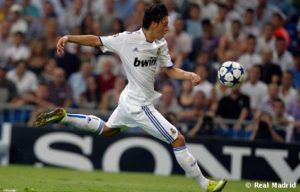
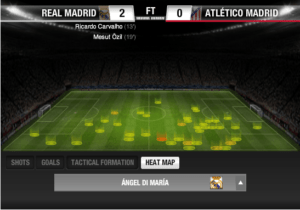
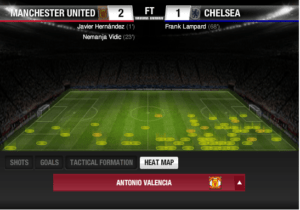
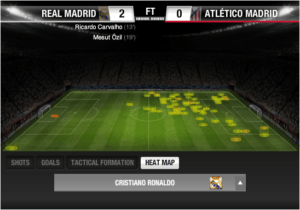
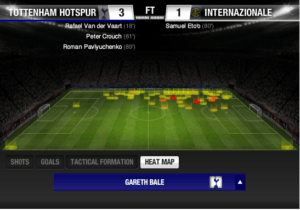
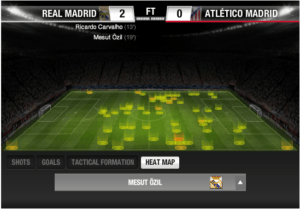
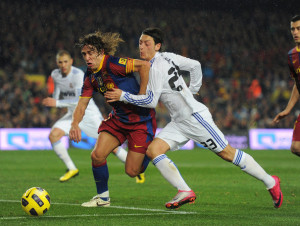








Recent Comments